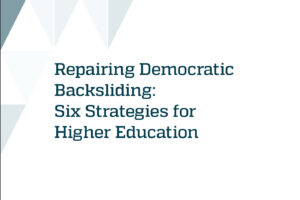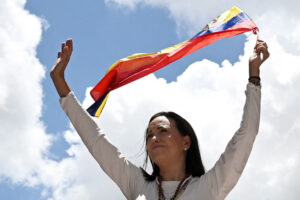
The unfettered pursuit of knowledge and the free exchange of ideas have always been a hallmark of higher education. But we are at a moment when the political order that undergirds and makes such work possible is under pressure due to global democratic decline. What does the research teach us about what can be done in such a moment? A new report by Jonathan Pinckney and Humza Khan, “Repairing Democratic Backsliding: Six Strategies for Higher Education,” synthesizes existing research to offer concrete ways that colleges and universities can push back on democratic backsliding. Drawing on decades of research, the authors argue that higher education communities hold a unique power to counteract incremental threats to democracy before they take deeper root.
The report describes how democratic decline rarely unfolds in one dramatic moment. Instead, it progresses gradually through small policy changes, complex judicial rulings, or quiet adjustments to media and information practices that the public often overlooks. Because universities combine scholarly expertise with public engagement and a diverse student body, the report argues that they can detect these subtle warning signs early and help communities recognize them. The report concludes that by adopting the six strategies outlined in their report, higher education institutions can play a vital role in reinforcing democracy in this moment.
“At SNF Agora, we believe democracy thrives when rigorous research intersects with real-world engagement,” says Hahrie Han, Inaugural Director of the SNF Agora Institute. “This report offers a review of existing research to diagnose the factors driving backsliding but also equip universities with practical steps they can take to safeguard our democratic future.”
“This report is designed to be a practical resource for colleges and universities that believe protecting democracy is part of their educational mission,” says Jonathan Pinckney. “By offering evidence-based strategies and showing exactly how campuses can intervene and empower those they serve, we hope it galvanizes institutions to step beyond academic discussion and actively fortify the values they stand for.”
Below are the six strategies that Pinckney and Khan recommend for colleges and universities seeking to defend democracy:
- Diagnose the Problem. The first strategy centers on identifying and communicating the antidemocratic moves that often remain hidden in technical or bureaucratic details. Authoritarian-leaning leaders exploit the public’s lack of awareness to bend institutions in their favor with little immediate backlash. Universities can serve as early-warning systems by using their research capabilities to translate complex changes into accessible, actionable information for local communities and broader audiences.
- Defend Free Expression. The second strategy concerns protecting the very spaces where democratic dialogues thrive. Students have historically been catalysts for social progress—from civil rights to environmental justice to calls for government accountability. Universities should remain vigilant against efforts to restrict peaceful protests or chill open discourse. Maintaining a robust culture of free expression doesn’t just uphold academic values; it also preserves a cornerstone of democracy.
- Bring People Together from Different Viewpoints. The third strategy directly confronts the dangers of political polarization. When citizens become entrenched in hostile ideological camps, politicians can demonize their perceived opponents and sideline authentic debate to gain power. Universities can counteract this trend by bringing people with different viewpoints together in structured fora and piercing ideological bubbles. Research shows that this approach reduces hostility and promotes more thoughtful civic engagement.
- Develop Democratic Dispositions among Elites. The fourth strategy underscores universities’ role in shaping tomorrow’s leaders. Politicians, CEOs, top lawyers, and influential journalists frequently form their political outlooks and begin their careers in higher education settings. By weaving democratic norms, respect for checks and balances, and accountability into leadership development programs or alumni networks, universities can cultivate elites who defend institutions—even when tempted to consolidate power.
- Dispel Misconceptions about Democracy. The fifth strategy highlights the danger of a “majority-rules-only” mentality. People undermine democracy when they assume that winning an election by popular vote grants leaders unrestricted power. Through courses and workshops, universities can highlight the equal importance of impartial courts, critical media, and civic freedoms. This broader perspective helps communities recognize how democracy erodes when oversight and minority rights disappear.
- Draw Together Long-Term Research. The final strategy calls on higher education institutions to launch ambitious, long-term studies that measure whether smaller interventions—like a single civic workshop or a semester-long class on democracy—can scale up to strengthen communities or regions over time. Such research would document immediate shifts in attitude and track real-world impact on policy, voting behavior, or the overall health of democratic practices. Colleges and universities, with their scholarly depth and partnerships, are well suited for this kind of investigation.
These strategies offer a roadmap for how colleges and universities can serve as protectors of civil discourse, incubators of pro-democratic leadership, and proactive voices warning of dangerous political shifts. For anyone who values free inquiry and fair governance, the report’s message is clear: the university campus is not just an ivory tower; it can also be a crucial arena where the future of democracy is debated, defended, and advanced.

